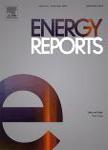版权所有:内蒙古大学图书馆 技术提供:维普资讯• 智图
内蒙古自治区呼和浩特市赛罕区大学西街235号 邮编: 010021

作者机构:Univ Dschang IUT FOTSO Victor Bandjoun Dept Genie Elect Unite Rech Automatique & Informat Appliquee UR AIA BP 134 Bandjoun Cameroon
出 版 物:《ENERGY REPORTS》 (Energy Rep.)
年 卷 期:2025年第13卷
页 面:1910-1926页
核心收录:
主 题:Maximum power tracking Permanent magnet synchronous generator Super-twisting algorithm Wind energy conversion
摘 要:This paper presents the super-twisting algorithm (STA) of a permanent magnet synchronous generator (PMSG) associated with a rectifier, a bidirectional DC-DC converter, and an inverter, all controlled by pulse width modulation (PWM). The bidirectional DC-DC converter, which feeds a battery, is controlled to maintain the DC bus voltage at a desired constant value. The purpose of the developed STA is to regulate the d-axis current, monitor the maximum power point, regulate the DC bus voltage by controlling the charge/discharge of a parallel-mounted battery, and regulate the voltage at the load. The STA was studied, and the results obtained were compared with the synergetic control method and the fractional-order PI control method. The results show that the mean value of the THD of the PMSG stator current for the synergetic control is 90.1%, for the FO-PI control is 94.80%, and for the STA is 94.85%;the mean value of the THD of the current at the load terminals is 0.92% for the synergetic control, 1.371% for the FO-PI, and 0.4775% for the STA;the mean value of the THD of the voltage at the load terminals is 1.22% for the synergetic control, 1.618% for the FO-PI, and 0.595% for the STA;the mean value of the relative error in rotational speed is 4.7306e-05 for the synergetic control, 7.9849e-04 for the FO-PI, and 4.5787e-04 for the STA;the mean value of the relative error in d-axis load terminal voltage is 0.0161 for the synergetic control, 0.0035 for the FO-PI, and 0.0023 for the STA;the mean value of the relative error in DC bus voltage is 0.0156 for the synergetic control, 0.0140 for the FO-PI, and 0.0067 for the STA. Simulations performed in the Matlab/Simulink numerical environment demonstrated the effectiveness of the proposed control method when the wind power system is operated under load variations and parameter uncertainties.